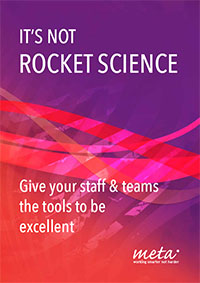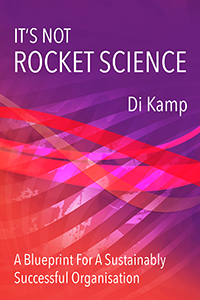We’ve been fortunate over the last few of years to have been working with many senior leaders in all three sectors (corporate, public, and third sector). One of the consistent themes that comes through the work we do with those leaders is the complaint that they don’t have the time or headspace to lead – which is concerning, but not unusual.
With the flattening of structures and streamlining of organisations, more responsibility now falls to the individual leader. They are rewarded for their management skills and ability to deliver, rather than their leadership skills, and with reduced headcount in almost every team or department, they have fewer people to get done what needs to be done.
So that means the leader gets dragged back into the operational aspects, which leaves a leadership gap at the top. Who is leading? Who’s steering the ship? Who is charting the way in the chaotic seas of the current business landscape? (Or should that be seascape? :D)
From our research we have found the biggest issue that leaders have is finding/creating time for being strategic, for planning ahead. They are so tied up with back-to-back meetings, with fires that need putting out, with the urgent, that they’ve barely got time to do their actual job. In fact, we have met many claiming that it’s really only at the end of the day that they get time to do much of their own to-do lists – to do the job that they’re actually paid to do.
There is just SO MUCH that needs to get done now, with notably lower resources (be that budgets or numbers in your team), and there’s barely enough time to think. It can be overwhelming and, certainly, the day-to-day becomes all consuming. It’s difficult to break away from the cycle of putting out fires and responding to the insatiable demands of organisational delivery, but it’s incredibly important that we do. Without leadership there is no vision, no direction, and with no-one steering the ship, you’ll end up just going around in circles and, ultimately, are likely to run aground.
The principal problem as we see it, is “capacity”.
Right now, we’re all struggling with the problem of capacity. In organisations now, as they have been slimmed down to the bare bones, there is just no capacity other than that which is quantifiably needed to deliver what needs to be delivered.
There is NO spare capacity in organisations anymore. No buffer, no extra capacity or resource built in for when something unexpected happens, no spare capacity in our teams if we have more than one person off longer term.
The simple fact is that most of you who are reading this will be admirably doing a leadership role that was originally done by two or more people. Same work-load, if not greater, but just the one leader. This means that not only is your organisation working at full capacity most of the time (if not all of the time) but you are running at full capacity too!
- Do you struggle to work at the end of your day? (Like when you read the same line of that email over and over and over again?)
- Do you find it hard to concentrate, absorb or retain information? (Like that big report you have to read for the board meeting tomorrow?)
- Do you find yourself stuck in the operational weeds, getting caught up in things that are way below your pay grade? Or leadership level?
- Do you find yourself constantly fighting and putting out fires, that you know, actually, with a bit of forethought and planning, probably wouldn’t have started up in the first place?
If the answer is yes to any of the above. You need to clear some capacity.
You need to literally clear some brain space.
You need to create the [brain] capacity to lead.
Most leaders right now are working against their brains and against their bodies. At work you need to have your brain and body on-side. Work with them, and all is possible.. against them and it’s guaranteed to be a tough and challenging day ahead.
The simple fact is that your brain and body WANT to serve you. They try their best to do what they can for you, but if you’re not helping them, it’s hard for them to help you.
So, where do we start?
We start by understanding that SLEEP is your greatest leadership resource of all. With a good night’s sleep, you can be your amazing brilliant best. Without sleep you’re in trouble. Now I’m not going to go into why sleep is important here (please refer to previous articles I’ve written on sleep, which are available on LinkedIn and which you can read in part one and part two) but rest assured I’ve been doing this leadership stuff now for 22years. I have come to realise that SLEEP is not a luxury, it is a necessity, and the current sleeplessness epidemic in this country is the number one cause of many of our organisational and leadership issues.
The second thing to understand is that our brain needs FUEL to perform at its best. Over the last five years, we’ve seen a worrying trend in people not just missing or not taking lunch breaks, but not even having breakfast in the mornings!
If you woke up and your phone or laptop was on 25% battery charge would you just leave it? Would you think that battery life would get you through your entire day? No of course you wouldn’t! That would be STUPID – you plug it into an energy source (in that case, electricity!)
And yet, that’s what we are doing when we don’t eat breakfast, when we skip lunch. We’re expecting our brain to perform with no fuel, with no energy. When you look at it logically, is it any wonder that we struggle and find our work-days challenging?
So those two are the first stages to creating the brain capacity to lead.
The next is to understand that your brain needs to have regular breaks to clear capacity during the day.
I’m not going to go into the neuroscience of this in the article (come to one of our creating the brain capacity to lead workshops if you’d like to find out the science behind what I’m talking about) – but simply put, the conscious part of your brain (the part that you use for pretty much everything that you do in your average working day as a leader) has a tiny capacity, and limited processing power.
What this effectively means is that by lunchtime, for most leaders, these days, you’ll be feeling as if you are “full”. You haven’t got much brain space left to cram anything else in or process anything more. That’s because you are quite literally “at capacity”.
At that point there is NO POINT in doing anything else.
You need to stop. You need to take a small break and allow your brain a little time to clear you some capacity. It will do that IF you don’t keep trying to cram stuff in it. If you actually stop, you can clear capacity and then carry on at a decent performance level.
We call it taking “micro-breaks” and we ask people to remember this, saying “move your body, move your mind” because it’s important during those breaks that you physically move and help your brain to clear some capacity, and free up some brain space.
When we take these little breaks regularly through the day, when we fuel ourselves too, we are working with our brain and with our bodies, which allows them to serve us better and helps us to perform at our best more often.
Carry on working beyond your natural limits however, and your performance dips, then nose-dives (depending on just how far you got beyond your natural limits).
All leaders we’ve come across KNOW this instinctively – they KNOW that by 2.30pm if they’ve not taken their lunch or taken a break, they are not being effective. They know that they are not able to give 100% or anywhere near that. But they feel they must plough on in order to get everything done. Work beyond their limits, beyond their contracted hours, work into the night, work through their breaks, to try to get everything done.
During every leadership programme we run, when we are doing our “smarter working” day, I ask this simple question:
“Hands up if you feel that you have the time and capacity to get everything that you need to get done, done at the right level and at the right quality WITHIN your normal working hours (ie: your contracted hours).”
We must have asked this question of hundreds of leaders by now. And do you know what??
Not ONE single leader in five years has ever put their hands up.
Isn’t that fascinating? Isn’t that also just a tiny bit scary??
So that’s why it’s so important to right now be focussing on clearing and creating the brain capacity to lead in your leaders and in your leadership teams.
When our brains are full, when they are at capacity, it means that we are unable to perform at our best. We struggle to lead because we just don’t have the brain space to lead. There is a direct link between performance and brain capacity.
There is a direct link between quality and brain capacity too. When our brains are full we struggle to work at our normal quality level. Most leaders confess to us that, right now, with the work-pressures and time constraints they face, often 60-75% of quality has to do. Think about this for a moment. If quality is at 75%, even, that means that there is a considerable likelihood this will create extra work in the future – it will create the fires of the future, which that same leader gets caught having to try to put out.
There is a direct link too between creativity, innovation, and brain capacity. In order to be creative, in order to innovate, this requires brain space. We all know that we’re at our most creative when we aren’t on a deadline, when we have a little space and time to properly reflect, process, think and create.
When we are creative solutions are sustainable. Fixes are long-term, not short-term sticking plasters. When innovation thrives in our organisation, the organisation thrives.
Leadership requires us to think at many different levels. There’s thinking strategically, there’s thinking short-term, medium-term, and longer-term, there’s thinking broadly and systemically. As a senior leader we also need to rise above the operational, to get that over-arching meta-view to see the whole organisational/business landscape and plot a pathway forward.
Again, simply put, without capacity none of the incredibly important leadership and organisational stuff above is possible – so creating brain capacity is a no brainer! (Sorry couldn’t resist the pun.)
So, what to do? As individual leaders we need to reconnect with our brains and our bodies – we need to be working with them, not against them.
As organisations we need to be equipping our leaders with the tools which enable them to be at their best, we need to be helping them to create the brain capacity to lead.
Every leader we come across wants to give of their best, they want to be the best leader they can be. Help them to do that, give them the tools they need, and your organisation WILL THRIVE.
I hope that you’ve found this article useful. This is just a fraction of what we have on leadership and smarter working practices – if you’d like to have a conversation with us about how we can equip your leaders (and staff) with the tools they need to work smarter not harder, if you’d like to chat to us about how we can help your leaders to create the [brain] capacity to lead, then please don’t hesitate to get in touch.
We have a number of different programmes from a full-blown nine-module leadership team development journey to a three-module smarter working programme, to a single day workshop on creating the brain capacity to lead.
At Meta we’re passionate about sharing our research and our resources with our Meta family – so please do call on us. It’s part of our mission, our purpose to help you, your leaders, and your organisations, to thrive in the hybrid-era.
Have a wonderful month,
In peace,
Jo xx





Comments are closed.